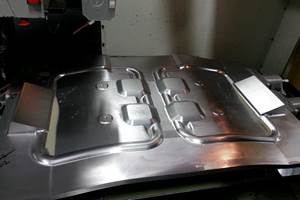Taking Steps To Improve Your Processes
Most of us recognize there is room for improvement in the way we do things. We would like to introduce these improvements, but unfortunately, with the daily pressures of meeting deadlines and doing whatever it takes to satisfy our customers, we just do not have the time.
Share





Most of us recognize there is room for improvement in the way we do things. We would like to introduce these improvements, but unfortunately, with the daily pressures of meeting deadlines and doing whatever it takes to satisfy our customers, we just do not have the time. Many companies use outside consultants to analyze existing processes and offer new ideas. A good consultant can assist a company in establishing a process improvement plan, then guiding the implementation of this plan.
One consultant with whom I have worked for many years is Richard Reale, president of Positive Impact Associates in Park Ridge, New Jersey. Mr. Reale has helped many manufacturers improve their operations by recognizing problems and working with employees to develop practical, proven solutions. Mr. Reale believes that many companies have similar types of problems and through simple analysis techniques can identify and resolve these problems.
Mr. Reale uses a series of questions that he has found effective in helping companies improve their processes. These questions are simple and can certainly be used for any type of process. Here they are in the order in which they should be addressed:
- Can we eliminate the process? Does each step in the process add value? Is the step a duplication of a previous or subsequent activity? Is the step a built-in correction that has been done unnecessarily for years? Steps such as filing, lifting, carrying, and inspecting are ideal candidates for elimination. Many companies move parts to temporary storage locations throughout a manufacturing cycle. This is an ideal type of process to eliminate, as there is no value added to any part by moving or storing it.
- Can we change the process? How can the operation be changed? Can different methods, tools, technologies or equipment be used to make the process better? Can we use less costly options? Does the operation have to be performed as frequently, and by as many people, as it is now? Can the operation be done faster? An example of a process that can be changed is deburring. It may be more economical to deburr a part automatically, using a vibratory finishing machine, than using hand tools.
- Can we rearrange the process? Is the process designed in the most efficient manner? Do people working on the process have to walk a great deal? Would changing the layout eliminate some of the handling or transportation steps now employed? Is the operation sequenced properly? Do we need to complete all operations sequentially, or can some be performed in parallel? An example of rearranging a process is transforming from a departmentalized process to a series of product-focused work cells. In a work cell, many of the handling and transportation issues are eliminated because a product is started and finished in one self-sufficient work area.
- Can we combine steps in the process? Can any operations be combined? Can equipment be relocated so that we can machine a part and assemble it in one operation? Can our suppliers perform some operations more effectively? Can our customers perform some operations more effectively? By combining operations, we can eliminate much of the non-value-added work required when moving parts from one operation to another. Performing secondary machining work during a CNC machining cycle is a good example of effectively combining operations.
- Can we simplify the process? What is the simplest way to achieve the objective or outcome of the process? Are we taking full advantage of tooling and fixturing to assist the operators? Are instructions easy to understand? Has all the necessary information been made available, including “helpful hints” or “pitfalls” inherent in the process? Replacing hand assembly of mechanical fasteners with an ultrasonic welding process, which requires fewer parts, is an example of simplifying a process.
- Can we imagine the perfect process? If we had no constraints, what would the perfect process be? How much time would it take? Would we get a better yield rate? Could we ship product to our customers faster? How much different is the perfect process from the present process and how can we get there? Can the perfect process be documented, either with a flow chart or series of simple bullet points? We may never achieve the perfect process, but that does not mean we should stop trying to get there.
Addressing questions such as those shown above can start any company on the road to process improvement. If you do not have the time or resources to do this yourself, consider getting outside help to improve your processes.
Related Content
2 Secondary Coordinate Systems You Should Know
Coordinate systems tell a CNC machine where to position the cutting tool during the program’s execution for any purpose that requires the cutting tool to move.
Read MoreTips for Designing CNC Programs That Help Operators
The way a G-code program is formatted directly affects the productivity of the CNC people who use them. Design CNC programs that make CNC setup people and operators’ jobs easier.
Read MoreObscure CNC Features That Can Help (or Hurt) You
You cannot begin to take advantage of an available feature if you do not know it exists. Conversely, you will not know how to avoid CNC features that may be detrimental to your process.
Read More4 Tips for Staying Profitable in the Face of Change
After more than 40 years in business, this shop has learned how to adapt to stay profitable.
Read MoreRead Next
Last Chance! 2025 Top Shops Benchmarking Survey Still Open Through April 30
Don’t miss out! 91ĘÓƵÍřŐľÎŰ's Top Shops Benchmarking Survey is still open — but not for long. This is your last chance to a receive free, customized benchmarking report that includes actionable feedback across several shopfloor and business metrics.
Read MoreAMRs Are Moving Into Manufacturing: 4 Considerations for Implementation
AMRs can provide a flexible, easy-to-use automation platform so long as manufacturers choose a suitable task and prepare their facilities.
Read MoreMachine Shop MBA
Making Chips and 91ĘÓƵÍřŐľÎŰ are teaming up for a new podcast series called Machine Shop MBA—designed to help manufacturers measure their success against the industry’s best. Through the lens of the Top Shops benchmarking program, the series explores the KPIs that set high-performing shops apart, from machine utilization and first-pass yield to employee engagement and revenue per employee.
Read More




















